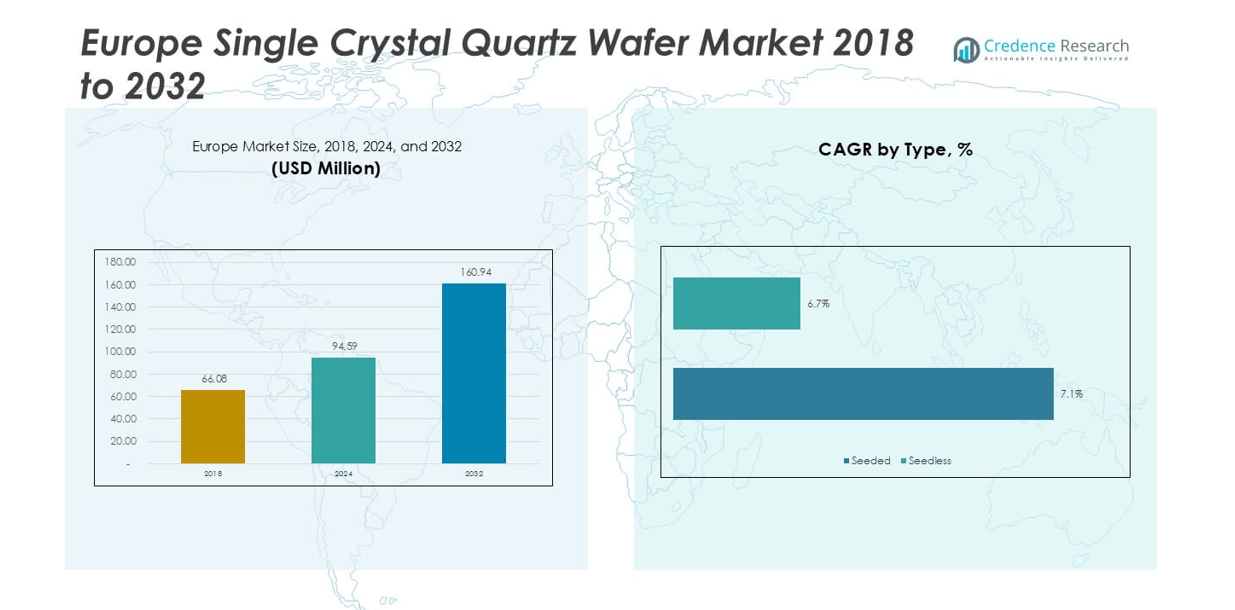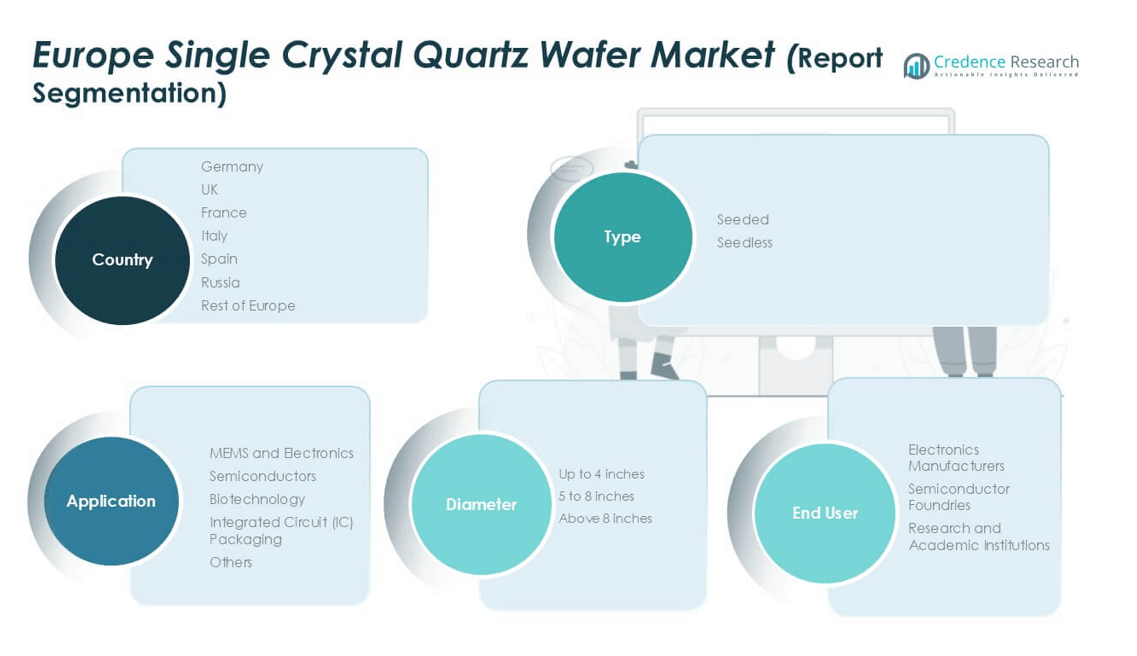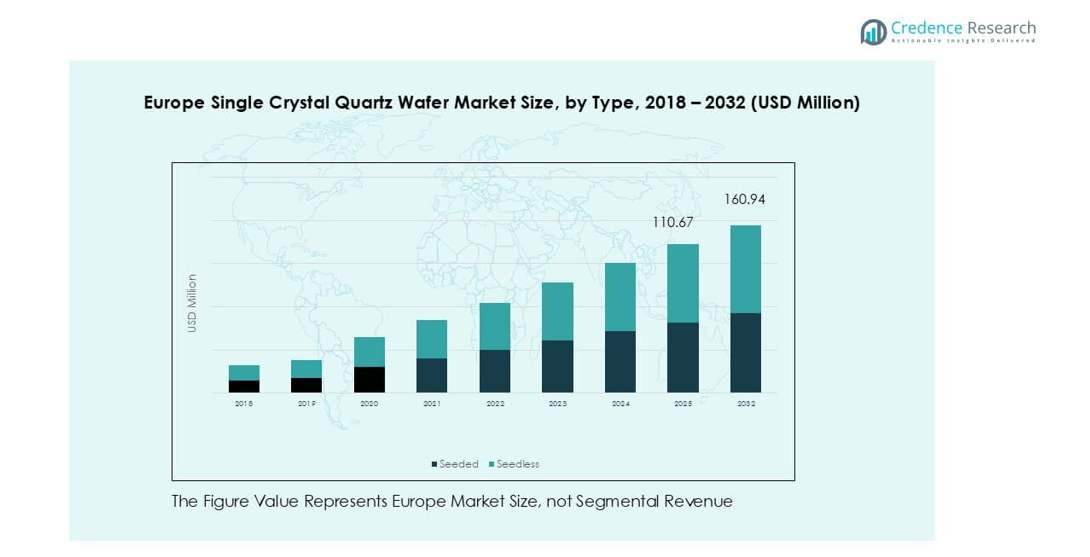Market Overview
The Europe Single Crystal Quartz Wafer market size was valued at USD 66.08 million in 2018, reaching USD 94.59 million in 2024, and is anticipated to hit USD 160.94 million by 2032, at a CAGR of 6.85% during the forecast period.
| REPORT ATTRIBUTE |
DETAILS |
| Historical Period |
2020-2023 |
| Base Year |
2024 |
| Forecast Period |
2025-2032 |
| Europe Single Crystal Quartz Wafer Market Size 2025 |
USD 94.59 million |
| Europe Single Crystal Quartz Wafer Market, CAGR |
6.85% |
| Europe Single Crystal Quartz Wafer Market Size 2032 |
USD 160.94 million |
The Europe single crystal quartz wafer market is led by key players such as SIEGERT WAFER GmbH, Corning Incorporated, NIHON DEMPA KOGYO CO., LTD., MTI Corporation, and Semiconductor Wafer, Inc. These companies hold strong positions through advanced manufacturing capabilities, broad product offerings, and strategic partnerships across semiconductor and MEMS industries. Germany emerges as the leading region, accounting for over 25% market share in 2024, driven by its robust semiconductor ecosystem, automotive electronics base, and Industry 4.0 initiatives. France and the United Kingdom follow with notable shares, supported by advancements in biotechnology, healthcare, and defense technologies. The combined strength of these players and regions positions Europe as a critical hub for quartz wafer innovation and adoption.

Market Insights
- The Europe single crystal quartz wafer market was valued at USD 94.59 million in 2024 and is projected to reach USD 160.94 million by 2032, growing at a CAGR of 6.85%.
- Growth is driven by rising semiconductor production, strong adoption in MEMS and electronics, and expanding demand from biotechnology and healthcare applications.
- Key trends include a shift toward larger-diameter wafers, integration in 5G and IoT devices, and increasing R&D investments under the EU Chips Act to strengthen the regional semiconductor ecosystem.
- The market is moderately consolidated, with leading players such as SIEGERT WAFER GmbH, Corning Incorporated, NIHON DEMPA KOGYO CO., LTD., and MTI Corporation focusing on technology innovation and partnerships, while new entrants target niche applications.
- Regionally, Germany leads with over 25% share, followed by France at 15%, the UK at 12%, Italy at 10%, Spain at 8%, Russia at 7%, and the Rest of Europe collectively holding 23%.
Access crucial information at unmatched prices!
Request your sample report today & start making informed decisions powered by Credence Research Inc.!
Download Sample
Market Segmentation Analysis:
By Type
The seeded quartz wafer segment dominated the Europe single crystal quartz wafer market in 2024, accounting for over 65% share. Seeded wafers are preferred due to their superior crystalline quality, stability, and low defect density, which make them ideal for semiconductor and MEMS manufacturing. Their consistent lattice structure supports precision in high-frequency applications and optoelectronic devices. The seedless segment remains smaller but is gaining adoption for niche applications requiring high-purity structures. Demand from electronics and advanced packaging continues to drive growth for seeded wafers across European semiconductor hubs.
- For instance, Heraeus Covantics, located in Germany, produces high-purity quartz and fused silica components for the semiconductor manufacturing industry. The company offers a variety of materials, some with impurity levels in the parts-per-billion range, for applications that accommodate industry-standard wafer sizes, including 200 mm and 300 mm.
By Diameter
Wafers sized 5 to 8 inches led the market in 2024, holding around 55% share. This dominance is linked to their extensive use in semiconductor production and MEMS devices, where mid-sized wafers balance cost-efficiency and high output. European foundries and research institutes favor this diameter for its scalability in IC packaging and advanced electronics. Smaller wafers, up to 4 inches, are primarily used in specialty and R&D applications, while above 8-inch wafers are emerging in high-volume semiconductor lines, reflecting future opportunities as fabrication technologies advance.
- For instance, Soitec in France uses 200 mm silicon-on-insulator (SOI) wafers for MEMS substrates, serving clients in the automotive and mobile communications industries.
By Application
The semiconductor segment accounted for the largest share of over 40% in 2024, driven by Europe’s strong base in microelectronics, automotive electronics, and industrial automation. Single crystal quartz wafers are essential for ensuring signal stability, thermal resistance, and precision in semiconductor devices. MEMS and electronics follow closely, supported by growing adoption in sensors, wearables, and smart devices. Biotechnology applications are rising steadily due to demand for advanced diagnostic tools and biosensors. Integrated circuit packaging also shows growth, supported by Europe’s increasing investments in semiconductor value-chain resilience.
Key Growth Drivers
Rising Semiconductor Manufacturing in Europe
Europe’s growing focus on semiconductor manufacturing is a primary driver of the single crystal quartz wafer market. The European Union has launched the EU Chips Act, targeting significant investments to strengthen the semiconductor supply chain. Quartz wafers play a critical role in semiconductor device fabrication, ensuring high thermal stability and signal precision. Countries such as Germany, France, and the Netherlands are expanding fabrication facilities to reduce dependency on imports. The rising demand for high-performance chips in automotive, aerospace, and industrial automation applications further boosts adoption. As electric vehicles and 5G networks proliferate, the need for precision substrates expands, positioning quartz wafers as a core material supporting Europe’s long-term technological competitiveness.
- For instance, Infineon Technologies is investing €5 billion in a new 300 mm fab in Dresden, designed for a capacity of over 400,000 wafers annually, all requiring precision quartz substrates for photolithography.
Expanding MEMS and Electronics Applications
Microelectromechanical systems (MEMS) and advanced electronics are witnessing rapid adoption across Europe, creating sustained demand for quartz wafers. MEMS devices, including accelerometers, gyroscopes, and pressure sensors, are integral to automotive safety systems, industrial robotics, and consumer electronics. Quartz wafers are crucial for ensuring frequency stability and miniaturization in these devices. The integration of MEMS into medical technologies and wearable electronics is further broadening the application scope. With Europe prioritizing smart manufacturing and Industry 4.0, MEMS deployment continues to accelerate. The region’s automotive sector, driven by autonomous and connected vehicle technologies, significantly contributes to MEMS demand, further strengthening quartz wafer consumption. This expanding role of MEMS across multiple sectors cements quartz wafers as indispensable for technological innovation and commercial growth.
- For instance, Bosch produces more than 4 million MEMS sensors per day at its wafer fabs in Reutlingen and Dresden, many based on quartz substrates for automotive and smartphone applications.
Biotechnology and Healthcare Advancements
The growing role of biotechnology and healthcare technologies is another key driver for the Europe quartz wafer market. Quartz wafers are used in biosensors, diagnostic systems, and lab-on-chip devices, enabling high sensitivity and reliable performance. Europe’s healthcare sector is adopting advanced analytical systems to support personalized medicine, point-of-care diagnostics, and genomic studies. Increasing investment in biotech R&D, supported by both government and private initiatives, accelerates demand for precision substrates. Additionally, the COVID-19 pandemic highlighted the importance of advanced diagnostic technologies, spurring greater focus on biosensor innovation. As healthcare providers continue to adopt smart and portable medical devices, the demand for quartz wafers in biotechnology expands, ensuring long-term growth across life sciences and healthcare applications.

Key Trends & Opportunities
Shift Toward Larger-Diameter Wafers
The transition toward larger-diameter quartz wafers presents a significant opportunity for manufacturers in Europe. While 5–8-inch wafers currently dominate, the move toward above 8-inch wafers aligns with the region’s push for high-volume semiconductor production. Larger wafers increase yield per batch, lowering manufacturing costs and enabling scale. As semiconductor fabs in Europe expand capacity under the EU Chips Act, demand for advanced wafer sizes is expected to grow. This shift creates opportunities for suppliers to innovate in wafer manufacturing technologies, addressing rising needs for efficiency, uniformity, and defect-free production. Larger wafers also align with long-term goals of strengthening Europe’s semiconductor autonomy.
- For instance, GlobalWafers Europe has piloted 300 mm (12-inch) wafer production in Germany, achieving defect densities below 200 cm⁻² to support next-generation IC packaging.
Integration with 5G and Emerging Technologies
The rollout of 5G networks and growth of emerging technologies such as IoT, AI, and advanced automotive systems open significant growth opportunities. Quartz wafers ensure signal accuracy and stability, making them critical for RF components and communication devices. With Europe investing heavily in 5G infrastructure, the need for reliable substrates is expanding. Moreover, applications in smart cities, autonomous vehicles, and defense electronics are increasing reliance on quartz wafers. Manufacturers positioned to meet the requirements of high-frequency and low-loss performance will benefit from these technology-driven opportunities. This trend also reflects Europe’s broader shift toward digital transformation and connected ecosystems.
Key Challenges
High Manufacturing Costs and Complexity
One of the key challenges for the Europe quartz wafer market is the high cost and complexity of production. The manufacturing of single crystal quartz wafers requires advanced crystal growth techniques, precision cutting, and defect control, which result in significant capital investment. Small and mid-scale players often struggle to compete with large-scale global suppliers. Additionally, achieving consistent quality at larger wafer diameters increases production costs. This cost barrier limits the widespread adoption of quartz wafers in price-sensitive applications and slows down regional production scalability. Companies must invest in cost optimization and advanced process technologies to overcome this challenge.
Supply Chain Dependencies and Raw Material Constraints
The market faces challenges related to supply chain dependencies and limited availability of high-quality quartz. Europe relies on imports of raw materials and equipment, which exposes manufacturers to global supply chain disruptions. Political tensions, trade restrictions, and logistical bottlenecks further intensify risks. Moreover, the niche requirement for defect-free quartz crystals narrows the supplier base, creating vulnerability in sourcing. These constraints hinder the region’s ability to scale local manufacturing and compete globally. Addressing this challenge requires strategic investments in domestic supply chains, resource security, and partnerships to ensure stable access to high-purity quartz for wafer production.
Regional Analysis
Germany
Germany dominated the Europe single crystal quartz wafer market in 2024, accounting for over 25% share. The country’s leadership stems from its advanced semiconductor manufacturing base, robust automotive electronics sector, and strong R&D ecosystem. German companies are at the forefront of microelectronics and MEMS applications, supported by government-backed initiatives under the EU Chips Act. Demand from electric vehicle technologies and Industry 4.0 integration further strengthens the market. The presence of leading automotive OEMs and technology developers ensures continuous adoption of quartz wafers for precision components, making Germany the regional hub for innovation and production.
France
France held around 15% share of the Europe single crystal quartz wafer market in 2024, driven by a growing focus on semiconductor research and microelectronics innovation. Strong investment in aerospace, defense, and biotechnology supports wafer demand across high-precision applications. The country’s semiconductor ecosystem benefits from collaborations between research institutions and industrial players, boosting adoption in MEMS and integrated circuits. Expanding adoption of biosensors and lab-on-chip devices in healthcare also strengthens growth. France’s balanced mix of industrial and healthcare-driven demand ensures its position as a significant contributor to the regional market.
United Kingdom
The United Kingdom captured approximately 12% share in the 2024 market, supported by expanding applications in biotechnology, healthcare, and advanced electronics. Strong demand for biosensors, diagnostic tools, and integrated medical devices drives quartz wafer usage. The UK’s semiconductor and electronics industry is relatively smaller but benefits from innovation-focused investments in start-ups and research labs. Demand is also fueled by defense technologies and precision communication systems. With growing emphasis on healthcare innovation and diagnostics, the UK market is set to expand steadily, positioning itself as a niche but vital player in Europe’s quartz wafer ecosystem.
Italy
Italy accounted for nearly 10% share of the Europe single crystal quartz wafer market in 2024, with growth supported by industrial automation and microelectronics adoption. Italian companies are increasingly leveraging quartz wafers for MEMS sensors, which are widely used in manufacturing and automotive applications. Strong ties to the European semiconductor value chain support domestic consumption. In addition, healthcare and biotechnology sectors are adopting quartz-based substrates for diagnostic equipment. Italy’s ongoing digitalization and Industry 4.0 programs enhance demand for precision substrates, ensuring steady growth while maintaining a competitive role within Southern Europe’s technology landscape.
Rest of Europe
The Rest of Europe region, including countries such as the Netherlands, Switzerland, and Nordic nations, collectively held around 38% share in 2024. The Netherlands plays a key role due to its semiconductor equipment manufacturers and strong R&D base, while Switzerland contributes through biotech innovation and precision electronics. Nordic countries are investing in smart manufacturing and clean technologies, creating new opportunities. This diverse regional cluster benefits from cross-border collaborations, EU-funded initiatives, and strong export capabilities. The combined strength of these markets ensures that Rest of Europe contributes significantly to driving technological advancement and supply chain resilience.

Market Segmentations:
By Type
By Diameter
- Up to 4 inches
- 5 to 8 inches
- Above 8 inches
By Application
- MEMS and Electronics
- Semiconductors
- Biotechnology
- Integrated Circuit (IC) Packaging
- Others
By End User
- Electronics Manufacturers
- Semiconductor Foundries
- Research and Academic Institutions
By Geography
- Germany
- UK
- France
- Italy
- Spain
- Russia
- Rest of Europe
Competitive Landscape
The Europe single crystal quartz wafer market features a moderately consolidated competitive landscape, with a mix of established multinational corporations and specialized regional suppliers. Key players such as SIEGERT WAFER GmbH, Corning Incorporated, and NIHON DEMPA KOGYO CO., LTD. dominate through their strong manufacturing capabilities, extensive product portfolios, and partnerships across semiconductor, MEMS, and biotechnology industries. Emerging companies like MTI Corporation, MicroChemicals GmbH, and Neyco are strengthening their positions by focusing on niche applications, high-purity wafers, and customized solutions for research institutions and advanced electronics. Strategic collaborations with European semiconductor fabs and R&D centers are increasingly common, enabling suppliers to align with the EU Chips Act and regional supply chain resilience goals. Continuous investment in large-diameter wafer technologies, defect-free crystal growth, and cost optimization strategies define the competitive edge. Recent developments also highlight growing participation from Asian manufacturers entering the European market, intensifying competition and driving innovation across applications.
Shape Your Report to Specific Countries or Regions & Enjoy 30% Off!
Key Player Analysis
- SIEGERT WAFER GmbH
- Semiconductor Wafer, Inc.
- MTI Corporation
- Corning Incorporated
- Vritra Technologies
- Neyco
- MicroChemicals GmbH
- NIHON DEMPA KOGYO CO., LTD.
- Hangzhou Freqcontrol Electronic Technology Ltd.
- UniversityWafer, Inc.
- Other Key Players
Recent Developments
- In July 2025, Xiamen Powerway (PAM-XIAMEN) remains an active supplier of single crystal quartz wafers, specializing in X-cut, Y-cut, Z-cut, and ST-cut orientations up to 3-inch diameters.
- In July 2025, NDK highlighted its advancement in mass-producing high-uniformity quartz crystals using proprietary technologies. Their latest offering includes synthetic quartz wafers with AT-cut and tuning fork wafers, and a development plan for larger 6-inch wafers to cater to growing SAW device demand and frequency control in next-gen electronics.
- In August 2024, NDK (NIHON DEMPA KOGYO CO., LTD.) showcased its synthetic quartz crystals and quartz wafers for timing and optical applications at electronica India 2024, participating through a distributor’s booth at the trade fair.
Report Coverage
The research report offers an in-depth analysis based on Type, Diameter, Application, End-User and Geography. It details leading market players, providing an overview of their business, product offerings, investments, revenue streams, and key applications. Additionally, the report includes insights into the competitive environment, SWOT analysis, current market trends, as well as the primary drivers and constraints. Furthermore, it discusses various factors that have driven market expansion in recent years. The report also explores market dynamics, regulatory scenarios, and technological advancements that are shaping the industry. It assesses the impact of external factors and global economic changes on market growth. Lastly, it provides strategic recommendations for new entrants and established companies to navigate the complexities of the market.
Future Outlook
- The market will expand steadily with rising demand from semiconductor manufacturing in Europe.
- MEMS and sensor applications will drive strong adoption across automotive, healthcare, and consumer electronics.
- Larger-diameter wafers will gain traction as fabs scale up high-volume production.
- Biotechnology and diagnostic devices will emerge as significant growth contributors.
- Germany will continue leading, supported by advanced industrial and automotive electronics ecosystems.
- France and the UK will strengthen their positions through healthcare, defense, and microelectronics demand.
- Strategic collaborations between suppliers and European R&D centers will accelerate innovation.
- Competition from Asian manufacturers will increase, intensifying technology differentiation.
- Supply chain localization efforts under the EU Chips Act will enhance regional resilience.
- Sustainability and cost optimization in wafer production will shape long-term market strategies.










